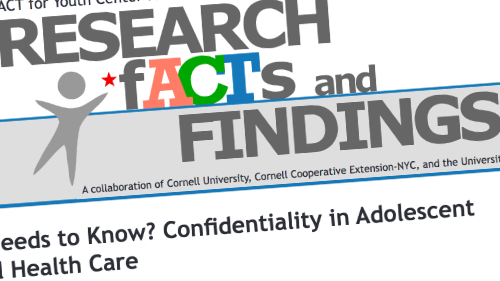PREP: Referrals to Youth Services
Referral is the process of assisting young people to meet their physical, social, emotional, educational, and developmental needs by connecting them to health or community services (such as referral types listed in the biannual report). Referrals are an important element of the PREP initiative. Note that providing general information about existing community services using brochures, etc. is not a referral.
Initiating the Referral Process
The referral process can be initiated by a young person seeking assistance or by an educator noticing a young person's need. It begins with a one-on-one meeting with a young person who has expressed the need or desire to access services.
Meet with the Young Person
- Build rapport: Creating an environment of trust and comfort is critical for the referral process. Using communication strategies such as open-ended questions, active listening, and affirmations and validations will help build rapport with the young person. Young people are looking for adults to talk to who are non-judgmental, approachable, informed, and respectful.
- Explain confidentiality and consent: Adolescents are concerned about privacy and confidentiality. This is often the main reason they do not seek out medical care. Therefore, it is very important to inform them about confidentiality laws and limitations, as well as their right to consent to services, so that they will feel comfortable disclosing sensitive information.
- Identify the young person's needs: Once you have built rapport, engaging the young person in an informal conversation may be sufficient to identify needs. Young people who feel comfortable and know they are accepted are more likely to express their needs.
Make and Document the Referral
- Select appropriate services and providers: Prior to meeting with young people, it is helpful to create a referral guide that gives descriptions of all the available services and providers (see below). With this detailed information at hand, solicit the young person's input and jointly determine which service and provider would be a good fit for them. Issues to consider include past experiences, preferences, location, transportation, and costs.
- Make the referral: Provide information about the service and what they can expect. Assist young people in scheduling appointments. A verbal "walk-through" of the visit may ease the young person's anxieties.
- Identify potential obstacles and strategies: What steps do they need to take to get to the appointment and what might get in the way of keeping the appointment? Strategize with the youth to support them in following through.
- Document the referral: Referrals should be documented to ensure follow-through, and summarized in the biannual report. The simple referral tracking form below can optionally be used to facilitate the documentation.

Warm Referral
One strategy, known as a "warm" referral, involves the trusted adult making the first contact with the agency either in person or by phone. Acting on behalf of the young person, the adult explains the reason for the appointment. This process also enables the adult to provide the youth with the name of a contact person at the organization, which will increase their comfort level and enhance the likelihood that the youth will keep the appointment.
Follow Up
To ensure that the youth have obtained the services they need, it is important to track whether or not they followed through with the referral. There are a couple of ways to make this happen.
- Check in with youth: Set up a time to check in with the youth in person or via phone after the appointment.
- Check in with agency contact: Ask the young person if they are comfortable signing a release of information (see below) so that you can follow up with the organization they were referred to.
Creating a Health and Community Services Referral Guide
Create a referral guide that lists sexual health and community service providers in the area. Creating linkages and having a designated contact person who could advocate for the young person internally within each agency will make the referral process much smoother. The referral guide could also be based on existing community resource guides generated by county departments or human services coalitions. Information about available community services can be found online; see, for example, 211CNY. Your guide should include:
- Provider or agency name, phone number, and address
- Name of individual contact person (if available)
- Access information (location, transportation options, access considerations)
- General services (age range served, types of services, services for special populations)
- Reproductive and sexual health services (pregnancy and STI/HIV testing, contraception, condom availability, STI treatment, HPV vaccine, etc.)
- Cost of services (and availability of/eligibility for free services)
- Additional information (websites, minor's rights)
- Brochures (if available)

A Note about Sharing Information
Health care providers, educational institutions, and human service organizations keep client or consumer information confidential. For the referral agency to be able to follow up directly with an organization to find out if the young person has received services, the young person needs to give consent prior to the appointment. Typically, this involves a formal written referral and release of information signed by the young person. The release of information must clearly outline what information will be shared for what purpose. Most agencies have developed policies and procedures for this. It is highly recommended that agency guidance be followed in this matter.


